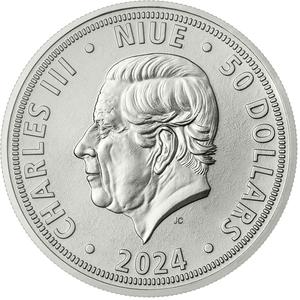Niue, a sovereign state in free association with New Zealand, uses two official legal tender currencies. The New Zealand Dollar is the circulation currency for daily transactions, while the government also authorises legal tender coins in the Niue Dollar currency for collector's purposes.
A number of mints issue a large variety of commemorative and collector coins under the authority of Niue. These coins are dedicated to historical or general popular culture themes not related to Niue itself. Many of them are in standard bullion sizes - such as the extremely rare one ounce of palladium format (abbreviated as 1 oz Pd).
The coins are "Non-Circulating Legal Tender" (NCLT) and not bullion because they are issued at prices much higher than their bullion value and are targeted at collectors who appreciate them for their artistic or sentimental value, and not at bullion investors.
This coin is part of the Czech Lion series of bullion coins issued every year by the Czech Mint with a new design.
The mint says about the series:
The best-known story of how the exotic lion became the symbol of the Czech country is the tale of Bruncvík - a mythical prince who travelled to Africa, where he helped the animal king to fight the dragon, belongs to the most famous stories of how an exotic lion became a symbol of the Czech land. Old chroniclers offer a more plausible explanation. According to them, Emperor Frederick Barbarossa rewarded Prince Vladislaus II with a royal crown and a new heraldic animal, which replaced the previous eagle in 1158.
The lion represented the knight's virtues, strength and courage, which were demonstrated by Vladislaus during the conquest of Milan in the imperial service. And how did the heraldic beast come to its second tail? Heroism played a key role again. King Ottokar I of Bohemia helped Emperor Otto IV. in the fight against the Saxons in 1204, and the Czech lion received a second tail for it, which distinguished it from the beasts of other nations and provided it with a unique prestige. However, medieval writers liked to colour their stories, therefore they are not a reliable source of information. The first verifiable Czech lion was a symbol of the Přemyslid dynasty and appears on the equestrian seal of Vladislaus Henry from 1203. Only Ottokar II, the Iron and Golden King, placed the lion on the coat of arms. | 



 Search for Niue: Palladium Ounce 2024 Czech Lion on eBay
Search for Niue: Palladium Ounce 2024 Czech Lion on eBay 

